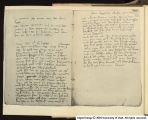| OCR Text |
Show 22 PAPERMAKIN number of samples of which he presented to the Académic de Sciences, recciving considerable praise for his initial attempts ‘The exact date of the introduction of wove moulds in Americ is not known, but it is thought to have been abou y referred to, the following is said regarding moulds of :ms ‘W: "When in England in 1832, Willia Matthews, son-in-law and successor of Fausett, I think was th name, mentioned some entries of a shipment of both wire fo ‘laidy' and ‘woven' wire for vellum moulds, to John Sellers, th father of Nathan, as far back as 1773, They were the only weaver of brass vellum (wove) wire at the time, and the principal mou makers in England. Their wire works were at Chepstone, on th River Wye." From this it would appear that wove paper was mad in America as early, if not carlir, than in France It is thought that the term wove in connection with papermaking was first used in the patent granted to Henry Fourdrinie and dated July 24th, 1806 (0. 2051). This specification reads i t: "The method of making a machine for m:\m\fi:zunng pape e indefinite length, laid and wove with scparat a number of moulds of the deseription called laid or wove, ar hooked or fastened together to form one long mould." This ter is again mentioned in the English pate of Ledger Didot, date tain other improvements upon the said machines for making bot wove and laid paper, etc." The definition given in Rees' Cyclopacdia, 1819, is as follows: "By a modern improvement, these mark (laid- and chain-lines) are avoided, and the paper has a smooth wove paper, as it is called when made on these moulds, i a ver superior article to the old paper, p1mcula|ly for books; but a prej Digital Imag © 2004 University of Utah. All rights reserved |



































































































































































































































































































































































































